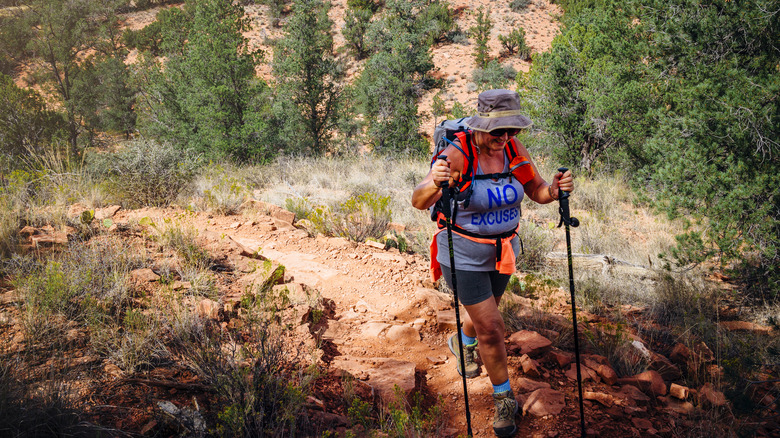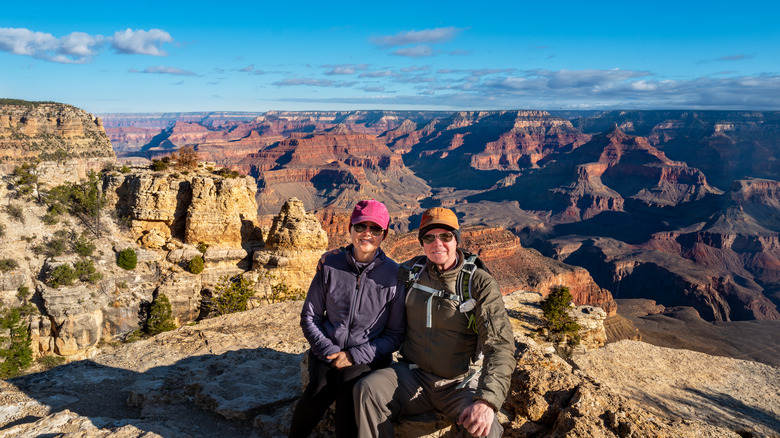Travel Guides Outdoor Adventures Hiking
Lee Adams
Nothing can quite prepare you for that first glimpse of the Grand Canyon. You can pore over photos and watch endless videos, but it still won’t ready you for the epic sweep of the canyon sprawling as far as the eye can see, carved through many layers of rock by the Colorado River over the past two billion years. Many of the national park’s annual 5 million visitors are content to gape at the humbling vista, take a few pictures, and maybe take a stroll along the top. But some more intrepid souls, less than 1% of the yearly footfall, are there to complete their journey of the rim-to-rim hike.
Viewing the distant North Rim from one of the vantage points on the more heavily-touristed South Rim, it’s hard to even wrap your head around what the distance actually entails. The two points are only 10 miles apart as the crow flies, but the trip from one to the other by car takes around four-and-a-half hours. To hike through the canyon itself involves a 24-mile trek, winding down to the banks of the river about a mile below before climbing back up the other side. The steep elevations in and out of the canyon mean that the rim-to-rim hike is only advisable if you are in good physical condition and well-prepared, and it’s certainly not an adventure to be taken lightly.
The Grand Canyon is America’s most dangerous national park

Solstock/Getty Images
Listed as one of the seven natural wonders of the world, the Grand Canyon is one of America’s must-see national parks. It’s also gained a reputation as one of the nation’s deadliest, claiming over 130 lives since 2007. In the summer of 2023, three people passed away: A 33-year-old visitor fell to his death from the Skywalk attraction, a 57-year-old woman perished while hiking in over 100-degree temperatures, and a 55-year-old hiker died attempting to go rim-to-rim in a single day.
The National Park Foundation warns that hiking the rim-to-rim trail is no easy feat — no matter which of the canyon’s two main routes you take. If you’re hiking from the South Rim to the North Rim, the trek follows the South Kaibab Trail and back up the North Kaibab Trail; in the opposite direction, you’ll descend via the North Kaibab Trail and come back up the Bright Angel Trail. While falls are a risk, high temperatures are the biggest danger. According to Wildland Trekking, the intense heat can lead to excessive sun exposure and dehydration, as well as potentially aggravating certain pre-existing medical conditions.
People of all ages successfully complete the journey and it’s an unforgettable experience that you’ll treasure for the rest of your life. The key thing is to make sure you’re well-prepared and physically fit enough to manage the demanding trail, and that you choose the right time of year to make the hike more comfortable.
How to prepare for the rim-to-rim hike

Nycshooter/Getty Images
While it’s possible to make the journey from rim to rim in a single day, a 2-3 day journey is a less demanding and more pleasurable experience. It’s essential to gear up adequately for the hike: Recommended equipment includes proper sneakers or lightweight boots, shades, a hat, sunscreen, a light, waterproof jacket, a first-aid kit, a change of clothes, snacks, and at least three liters of water. Experienced hikers recommend planning your trip in late May or early October when facilities at the North Rim are open and you can avoid the punishing summer temperatures. It gets hotter as you descend and the thermometer can top 100 degrees at the bottom of the canyon.
While spreading out the hike over a few days is more leisurely, you’ll need to sort out somewhere to sleep. The most sought-after location is Phantom Ranch, the only permanent lodging beneath the rim. It’s hard to secure a booking because reservations are determined by a lottery system; to have any hope, you should plan your visit over a year in advance. Landing a spot at a campsite below the rim is also quite difficult. Amenities are basic and you’ll need a backcountry permit to camp beneath the rim, which you can secure up to four months in advance. Demand is high so you need to get in fast. Camping also means that you’ll need to carry extra equipment unless you hire a mule to do it for you.

